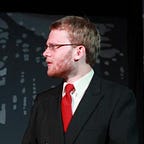These Two Maps Have Equal Population
This is what it looks like if you draw two maps of U.S. counties with equal population and put the most populous counties in one and the least populous counties in the other:
It’s a dramatic reminder of how uneven population is spread across the US. And the more you drill down, the more dramatic it gets. This is what it looks like if you draw two maps with equal population and put the most populous individual county (Los Angeles) in one and all the least populous counties with an equivalent population in the other:
When you drill down to smaller units of geography, you begin to see that the variation is even greater within counties. This is what it looks like if you draw two maps with equal population and put the most populous census tracts in one and the least populous tracts in the other:
The above map covers the entire¹ U.S. population. When you narrow it to, say, 10% of the population, it starts to get absurd:
Both of these maps contain 10% of the U.S. population. My favorite version of this is the one where each map contains 1% of the U.S. population:
This is silly, but has very substantial real-world consequences. The House of Representatives guarantees a minimum of 1 Representative to every State, no matter how small, giving a slight edge to less densely-populated areas. The Senate, on the other hand, is based solely on states with no regard population, and ends up weighting rural voters as much as 40 times more than urban ones. The Electoral College combines House and Senate representation, giving an edge to more rural States as well. In the above map, one of those sets of 3 million voters has substantially more power than the other.²
I leave to the reader the discussion of whether this is fair or not. With this essay I only seek to draw attention to the underlying question: can we reconcile an 18th-century constitutional system based on geography with the modern notion of 1 person, 1 vote? And if you think this doesn’t matter, think of how the world might look if Al Gore had been President on 9/11 or Hillary Clinton had been in charge of organizing our response to Covid-19.³ The implications of these silly maps are enormous.
Code and data can be found here. Thank you for reading!
[1] Except for Hawaii and Alaska, because I couldn’t figure out how to get GGplot2 to fit them into the tract-level map.
[2] Those of you from other countries may be wondering: why do we do it this way? The answer lies in the name, the United States of America. The idea that we are an assortment of sovereign States joined together in a Union means there is no such thing as a national election in the United States. The Federal Government does not and has never run a national election. Instead, 50 States (and D.C. and territories) run individual elections. Voters within these states choose state-level representatives in the House and Senate. “But what about the President?” you might ask. Even the vote for the President isn’t technically a vote for the President: it’s a vote for an electoral college elector, who in turn votes for the President. It hasn’t actually worked that way since 1824, but on paper that’s how it’s supposed to work.
[3] For further reading, this excellent article demonstrates how the 2016 Presidential Election would have worked with different configurations of U.S. States.
